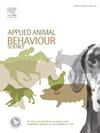“依恋”的生物学无关性——是时候从不同的角度看待猫了
IF 2.2
2区 农林科学
Q1 AGRICULTURE, DAIRY & ANIMAL SCIENCE
引用次数: 0
摘要
猫与人类的互动传统上被认为是一种不太完美的尝试,试图达到狗与人之间关系的复杂性。然而,为了理解猫的进化成功,我们需要一个生态学上有效的方法:为什么一种社会认知特征对猫是适应性的?我们对接受过动物辅助服务培训的“治疗猫”(N = 15)进行了测试,测试内容是修改版的安斯沃思奇怪情况测试,适用于评估动物与主人的依恋关系。我们还用与对照动物相同的实验方案测试了“普通”伴侣猫(N = 13)。使用“治疗猫”使我们能够避免在未知的实验室环境中进行测试时普通伴侣猫的强烈应激反应。正如预期的那样,我们发现“治疗”猫和普通伴侣猫在依恋情结的每个主要成分上都存在显著差异:“依恋”(P <; 0.001);“焦虑”(P = 0.005);“接受陌生人”(P <; 0.001)。“治疗猫”的“依恋”和“接受”得分明显高于普通宠物猫。“治疗”猫的“焦虑”得分明显低于普通宠物猫。然而,我们没有发现任何一组猫对主人有依恋的迹象。即使是接受治疗的猫,它们的行为没有受到未知场所强烈压力的阻碍,也没有对它们的主人表现出专属的避风港和安全基地型反应。它们对主人和陌生人表现得同样平静和友好。猫与人类表现出对称的种间友好关系,我们鼓励基于进化意义对它们的行为进行调查。我们发现,家猫在功能上保持了对人类的独立性,它们对主人没有依恋,这是基于依赖的狗与人关系的标志。我们认为,从生态学角度来看,这种物种不太可能产生依恋,因为它们保持了与人类的独立性。因此,我们认为现在是时候改变我们对猫的研究视角,更多地了解它们能教给我们的与人类发展互利但独立的关系的不同方式。本文章由计算机程序翻译,如有差异,请以英文原文为准。
The biological irrelevance of ‘Cattachment’ – It’s time to view cats from a different perspective
Cats’ interactions with humans were traditionally conceptualized as a less-than-perfect attempt to reach the complexity of the dog-human bond. However, to understand the evolutionary success of cats, we need an ecologically valid approach: why would a socio-cognitive trait be adaptive for the cat? We tested ‘therapy cats’ (N = 15) that were trained for Animal Assisted Services, in the modified version of the Ainsworth’s Strange Situation Test, suitable for the assessment of animals’ attachment bond with their owners. We also tested ‘regular’ companion cats (N = 13) with the same experimental protocol as control animals. The use of ‘therapy cats’ allowed us to avoid strong stress reaction of ordinary companion cats when tested in an unknown, laboratory environment. As expected, we found significant differences between the ‘therapy’ and regular companion cats in each of the main components of the attachment complex: ‘Attachment’ (P < 0.001); ‘Anxiety’ (P = 0.005); ‘Acceptance of the Stranger’ (P < 0.001). ‘Therapy’ cats received significantly higher ‘Attachment’ and ‘Acceptance’ scores than regular pet cats. The ‘Anxiety’ scores of ‘therapy’ cats were significantly lower than in the regular pet cats. However, we found no sign of attachment to the owner in any of the cat groups. Even therapy cats, whose behaviour was not thwarted by the strong stress at the unknown place, did not show exclusive Safe Haven and Secure Base-type reactions towards their owner. They behaved equally calm and friendly towards their owner and a stranger. Cats display symmetrical inter-specific amicability with humans, and we encourage their behavioural investigation to be based on evolutionary significance. We showed that domestic cats retained their functional independence from humans, and they do not show attachment towards their owners, which is a hallmark of the dependence-based, dog-human relationship. We argue that attachment would be ecologically unlikely in this species, as they preserved their independence from humans. Therefore, we believe it is time to change our research perspective on cats and find out more about what they can teach us about different ways of evolving mutually advantageous, but independence-based relationships with humans.
求助全文
通过发布文献求助,成功后即可免费获取论文全文。
去求助
来源期刊

Applied Animal Behaviour Science
农林科学-行为科学
CiteScore
4.40
自引率
21.70%
发文量
191
审稿时长
18.1 weeks
期刊介绍:
This journal publishes relevant information on the behaviour of domesticated and utilized animals.
Topics covered include:
-Behaviour of farm, zoo and laboratory animals in relation to animal management and welfare
-Behaviour of companion animals in relation to behavioural problems, for example, in relation to the training of dogs for different purposes, in relation to behavioural problems
-Studies of the behaviour of wild animals when these studies are relevant from an applied perspective, for example in relation to wildlife management, pest management or nature conservation
-Methodological studies within relevant fields
The principal subjects are farm, companion and laboratory animals, including, of course, poultry. The journal also deals with the following animal subjects:
-Those involved in any farming system, e.g. deer, rabbits and fur-bearing animals
-Those in ANY form of confinement, e.g. zoos, safari parks and other forms of display
-Feral animals, and any animal species which impinge on farming operations, e.g. as causes of loss or damage
-Species used for hunting, recreation etc. may also be considered as acceptable subjects in some instances
-Laboratory animals, if the material relates to their behavioural requirements
 求助内容:
求助内容: 应助结果提醒方式:
应助结果提醒方式:


